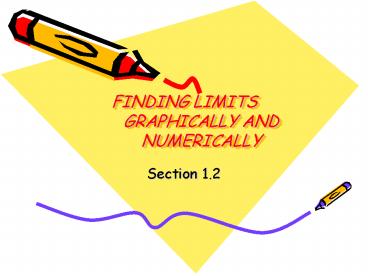FINDING LIMITS GRAPHICALLY AND NUMERICALLY - PowerPoint PPT Presentation
1 / 17
Title:
FINDING LIMITS GRAPHICALLY AND NUMERICALLY
Description:
Estimate a limit using a numerical or graphic approach. Learn different ways that a limit ... Common Types of Behavior Associated with Nonexistence of a Limit ... – PowerPoint PPT presentation
Number of Views:71
Avg rating:3.0/5.0
Title: FINDING LIMITS GRAPHICALLY AND NUMERICALLY
1
FINDING LIMITS GRAPHICALLY AND NUMERICALLY
- Section 1.2
2
When you are done with your homework, you should
be able to
- Estimate a limit using a numerical or graphic
approach - Learn different ways that a limit can fail to
exist - Study and use a formal definition of limit
3
AN INTRODUCTION TO LIMITS
- Consider the function
4
What is the domain?
- Both C and D
5
Consider the limit of this function as x
approaches 2.
- When graphing the function, we could factor the
numerator and cancel, keeping in mind there will
be a break in the graph at . - So we have
- which is the graph of a line with an open circle
at . - Lets first estimate the limit as x approaches 2
graphically. Or, writing this mathematically,
6
Evaluate the function at x 2
- 1
- undefined
7
Evaluate the limit of the function as x
approaches 2 graphically.
- 1
- DNE
8
Now, lets estimate
numerically using a table of values.
- Since is approaching 1 from the left and
right of 2, we may conclude that
9
LIMITS THAT FAIL TO EXIST
- Behavior that differs from the right to the left.
- Consider
10
What is the limit of the function as x approaches
0 from the right?
- 0
- Does not exist
- 2
11
What is the limit of the function as x approaches
0 from the left?
- 0
- Does not exist
- 2
12
What is the limit of the function as x approaches
0?
- 0
- Does not exist
- 2
13
UNBOUNDED BEHAVIOR
- Consider the function This is a
hyperbola with a vertical asymptote at - Notice that approaching x from either the left or
the right of 0, f increases without bound, that
is, f is approaching infinity, which is not an
actual number. - Therefore, we say the finite limit does not
exist.
14
OSCILLATING BEHAVIOR
- Consider the function
- Lets examine what happens as x approaches 0.
15
Common Types of Behavior Associated with
Nonexistence of a Limit
- approaches a different number from the
right side of c than it approaches from the left
side. - increases or decreases without bound as
x approaches c. - oscillates between two fixed values as
x approaches c.
16
Formal Definition of Limit
- Epsilon and delta
- Let f be a function defined on an open interval
containing c (except possibly at c) and let L be
a real number. The statement
means that for each there exists a
such that if then
17
Finding a for a given
- Given the limit
- find delta given that epsilon is 0.01.
- So where should you start?
- Hint Math is all about definitions!































